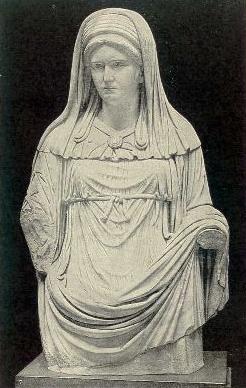The Vestals wore a headdress consisting of the suffibulum, a short, bordered veil; the infula, a woollen fillet wrapped several times around the head; and multiple vittae, woollen strands hanging down from the fillets.

Vittae were also worn by priests, brides, maidens, asylum-seekers, and sacrificial victims. Speculating on their symbolic function in The Marriage of Cadmus and Harmony, Roberto Calasso writes:
“Vittae dictae sunt, quod vinciant”: “The woollen ties are so called because they bind.” But what was this bond? It was the momentary surfacing of a link in that invisible net which enfolds the world, which descends from heaven to earth, binding the two together and swaying in the breeze. Men wouldn’t be able to bear seeing that net in its entirety all the time: they would get caught in it at once and suffocate. But every time someone achieves or is subjected to — but every achievement is subjection, and every subjection achievement — something that uplifts him and generates intensity and meaning, then the woollen strips, the ties, come out. [...] All these woollen strips, these vain, winged tassels, were nerves of the nexus rerum, the connection of everything with everything else, which alone gives meaning to life.